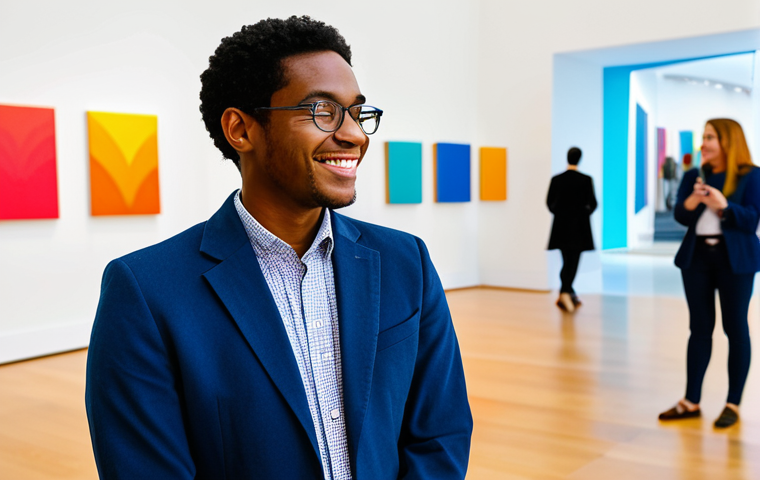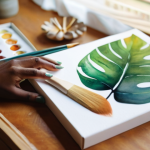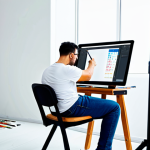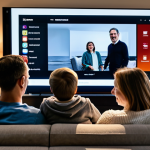Ever wonder what truly breathes life into our communities, beyond the everyday hustle? It’s often the subtle yet profound influence of art and culture, shaping our perspectives and narratives.
I’ve always been captivated by the minds that delve deep into this intricate world – cultural arts researchers. Their work isn’t just about dusty archives; it’s about understanding the very essence of human creativity and its impact on society, a topic that’s become incredibly dynamic in our rapidly evolving digital age.
Their insights are invaluable, providing a compass for navigating cultural landscapes that feel increasingly complex yet exciting. Let’s dive deeper into their fascinating insights below.
My own journey through various cultural exhibitions and local art initiatives has shown me firsthand how crucial it is to have dedicated minds analyzing these shifts.
When I reflect on how much the art world has transformed even in the last five years – from the explosion of NFTs and digital immersive experiences to the urgent conversations around decolonizing museums and promoting equitable representation – it’s clear that cultural arts research is more vital than ever.
What I’ve come to realize is that these researchers aren’t just observers; they’re often at the forefront, anticipating trends and flagging critical issues before they fully manifest.
For instance, the rise of AI-generated art poses thorny questions about authorship and authenticity, challenging long-held definitions of creativity. I remember feeling a genuine sense of unease, mixed with awe, after seeing a sophisticated AI piece that was indistinguishable from human work; it forced me to reconsider what ‘art’ truly is.
Looking ahead, my gut tells me we’re on the cusp of even more radical changes. Imagine cultural institutions leveraging advanced data analytics to understand audience engagement in real-time, or using virtual reality not just for display, but for preserving intangible cultural heritage that might otherwise be lost.
There’s also a growing imperative for cross-cultural collaboration, breaking down historical barriers and fostering a truly global dialogue through art.
This isn’t just about academic papers; it’s about practical applications that can enhance public access, foster innovation, and ensure that the arts continue to enrich our lives in meaningful, accessible ways, regardless of where you are or what your background is.
It’s a field that feels alive, constantly adapting, and frankly, absolutely essential for understanding our collective human story.
Decoding the Digital Shift: Art, AI, and Authenticity

The past few years have been nothing short of a whirlwind in the art world, haven’t they? It truly feels like every other week there’s a new technological breakthrough that forces us to rethink what art even is.
When I first heard about NFTs, my initial reaction was a mix of skepticism and utter fascination. Could digital files really hold value in the same way a physical masterpiece does?
As someone who’s spent countless hours wandering through galleries and experiencing art in its tangible forms, the idea felt almost alien. Yet, watching the market explode, seeing artists I admire embrace this new medium, and even experimenting with a few digital collectibles myself, I’ve come to appreciate the raw innovation it represents.
It’s a testament to how quickly our perception of value can shift, and it’s a goldmine for cultural arts researchers to dig into the economic, social, and philosophical implications.
One of the most profound shifts, in my personal experience, has been grappling with AI-generated art. I vividly recall attending an exhibition where some pieces were entirely conceived and executed by artificial intelligence. My first instinct was to search for the human touch, the brushstrokes, the subtle imperfections that betray the artist’s hand. But there were none. It was polished, profound, and frankly, a little unnerving. It raised a flurry of questions in my mind: Who is the artist? The programmer? The AI itself? Does intent matter when the outcome is so compelling? It really makes you pause and reconsider the very definition of creativity and authorship. Cultural researchers are right there in the thick of it, trying to establish new frameworks for copyright, authenticity, and intellectual property in this brave new world, which is absolutely critical because the legal and ethical quagmires are vast and complex. We’re charting totally new territory here, and it’s exhilarating and terrifying all at once.
1. Navigating Authorship in the Age of Algorithms
It’s like we’ve entered a new philosophical debate, isn’t it? When an algorithm learns from thousands of existing artworks and then generates something entirely novel, where does the originality truly lie?
I’ve seen some truly breathtaking AI art that could easily pass for human-made, and honestly, it challenges everything I thought I knew about artistic genius.
My own take, after quite a bit of contemplation and discussion with artists, is that while the AI might be the tool, the human who curates the data, writes the algorithms, and ultimately decides what to create or even showcase, remains the primary author.
But then, what about the AI’s “creative” decisions? It’s a messy, fascinating area. Cultural arts researchers are providing critical insights into how we define the “creator” in this evolving landscape, examining legal precedents and societal perceptions.
They’re asking the hard questions: Can an AI truly feel or express emotion, or is it merely simulating it based on patterns? And if it’s simulation, does that diminish the art?
I personally believe the dialogue around these questions is as important as the art itself, because it forces us to deepen our understanding of what it means to be human and creative.
It’s not just about technology; it’s about our identity.
2. The Elusive Quest for Digital Authenticity and Longevity
Beyond who made it, there’s the equally thorny issue of authenticity and permanence in the digital realm. With physical art, there’s a clear lineage, a provenance that can be traced back through time, sometimes centuries.
But with digital files, especially NFTs, how do you ensure their long-term authenticity and preservation? It’s not as simple as storing a painting in a climate-controlled vault.
There’s the risk of link rot, platform obsolescence, and the sheer ephemerality of digital data. I’ve personally experienced the frustration of trying to access old digital photos or files that are now in an obsolete format – imagine that on the scale of an entire cultural archive!
Cultural arts researchers are working tirelessly to develop robust digital preservation strategies, exploring everything from blockchain solutions to decentralized archiving methods.
They’re also grappling with the very concept of “originality” when a digital artwork can be copied perfectly, endlessly. What makes one NFT “original” when technically infinite identical copies can exist?
It’s a mind-bending problem, but one that absolutely must be solved if digital art is to be taken seriously as a lasting part of our cultural heritage.
We need these dedicated minds to ensure that the art of today isn’t just a fleeting trend but something that future generations can genuinely engage with.
Beyond the Canvas: Immersive Experiences and Audience Engagement
Stepping into an immersive art experience for the first time was genuinely transformative for me. It wasn’t just viewing art; it was *being in* the art.
The lights, the sounds, the way the images moved and enveloped me – it was a sensory explosion that traditional gallery visits, as much as I adore them, simply can’t replicate.
I remember feeling a profound sense of wonder, like a child discovering magic for the first time. This shift from passive observation to active participation is, in my opinion, one of the most exciting developments in the cultural sector.
Institutions are no longer just putting art on walls; they’re designing entire environments, narratives that you walk through, interact with, and become a part of.
Cultural arts researchers are at the forefront of studying the psychological impact of these experiences, understanding how they enhance engagement, memory retention, and even emotional connection.
They’re using data analytics to map audience flow, dwell times, and interaction points, giving curators invaluable insights into what resonates and what falls flat.
It’s a radical departure from the old ways, and it’s opening up incredible new avenues for artistic expression and public access.
1. The Data-Driven Revolution in Cultural Institutions
It used to be that understanding your audience felt more like an art than a science – relying on anecdotal evidence or basic visitor counts. But what I’ve witnessed recently is a dramatic shift towards data-driven insights, and it’s honestly game-changing.
Cultural institutions are finally catching up to other industries in leveraging real-time analytics to understand audience behavior. Imagine a museum knowing exactly which exhibits capture the longest attention, which pathways visitors most frequently take, or even how different demographic groups interact with a digital installation.
This isn’t just about numbers; it’s about deeply understanding human connection to art. Researchers are developing sophisticated models to interpret this data, helping institutions tailor their offerings, improve accessibility, and even predict future trends in audience interests.
I personally find it incredibly exciting because it allows for a more responsive, inclusive approach to cultural programming. It means less guesswork and more informed decisions that truly serve the community, ensuring that cultural experiences are not just preserved, but also perpetually relevant and engaging for everyone who walks through their doors.
It’s like having a superpower to anticipate what will truly move people.
2. Virtual Reality and the Preservation of Intangible Heritage
The concept of using virtual reality not just for display, but for the actual preservation of intangible cultural heritage, blew my mind when I first encountered it.
We’re talking about things that can’t be put in a museum case: traditional dance forms, oral histories, indigenous rituals, and even specific ways of preparing cultural dishes.
These are living, breathing traditions often passed down through generations, and sadly, many are at risk of being lost forever due to globalization, urbanization, or simply a lack of resources.
I remember watching a VR experience that recreated a traditional weaving ceremony from a remote village – I could almost feel the texture of the threads and hear the ancestral chants.
It was incredibly moving. Cultural arts researchers are pioneering methods to capture these ephemeral elements using advanced VR and AR technologies, creating immersive digital archives that can be experienced by anyone, anywhere, at any time.
This isn’t just about documentation; it’s about active preservation and transmission. It’s about ensuring that future generations, even if they can’t physically be there, can still experience and learn from these profound cultural practices.
For me, this feels like one of the most vital applications of technology in the cultural sphere, offering a lifeline to traditions that might otherwise fade into history.
Reshaping Narratives: Decolonization and Inclusivity in Cultural Spaces
The conversations around decolonizing museums and promoting equitable representation in the arts have intensified significantly in recent years, and honestly, it’s about time.
As someone who has always believed art should be for everyone, the historical imbalances within major institutions have often felt like a silent barrier.
I’ve personally felt the disconnect when walking through galleries dominated by a single narrative or perspective, realizing how many stories were simply not being told.
It’s not just about what’s on display; it’s about who gets to tell the story, whose history is prioritized, and whose voices are amplified. This isn’t just an academic exercise; it’s a deeply human one, recognizing the power of representation and the pain of historical exclusion.
Cultural arts researchers are playing a crucial role in dissecting these historical frameworks, challenging institutional biases, and advocating for more inclusive curatorial practices.
They’re facilitating dialogues, pushing for repatriation of artifacts, and helping institutions develop strategies to genuinely reflect the diverse communities they serve.
It’s a slow, challenging process, but one that feels absolutely essential for the future relevance and ethical standing of our cultural institutions.
1. Unpacking Historical Bias and Reimagining Curatorial Practices
When you start to really look closely, you realize that many of our cultural narratives, particularly in older institutions, are deeply embedded with colonial perspectives.
It’s not always overt; sometimes it’s in the way objects are categorized, the language used in labels, or simply what gets acquired and what doesn’t. I’ve often wondered how different my own understanding of history would be if I had encountered a more balanced, multi-vocal representation in my youth.
Cultural arts researchers are doing the vital work of unpacking these historical biases, delving into archives to expose problematic origins, and advocating for a fundamental shift in curatorial approaches.
This involves engaging with source communities, empowering marginalized voices, and critically re-evaluating acquisition policies. It’s a complex endeavor, requiring sensitivity and deep scholarly rigor, but the reward is a richer, more accurate, and more just portrayal of our shared human story.
It’s about more than just adding diverse artists; it’s about fundamentally reshaping the entire institutional mindset.
2. Championing Diverse Voices and Equitable Representation
The push for equitable representation isn’t just a trend; it’s a moral imperative, and one that resonates deeply with me. It’s about ensuring that art from all cultures, all genders, all backgrounds, and all abilities gets the platform and recognition it deserves.
I’ve been incredibly heartened to see more institutions actively seeking out and showcasing artists who have historically been sidelined. This isn’t merely about “checking a box”; it’s about enriching the entire cultural landscape, bringing new perspectives, new forms, and new stories to light that might otherwise remain unseen.
Cultural arts researchers are instrumental in identifying these underrepresented artists and movements, conducting research that brings their work to the forefront, and developing frameworks for genuinely inclusive programming.
They’re also studying the impact of such representation on audience engagement and societal perceptions, proving the tangible benefits of diversity. It’s about creating a cultural ecosystem where everyone can see themselves reflected, and where every voice has the chance to contribute to the grand tapestry of human creativity.
The Lifeline of Culture: Funding, Sustainability, and Policy Innovation
It’s a tough truth that even the most innovative and impactful cultural projects often live or die by their funding. I’ve witnessed firsthand the passion and dedication of artists and cultural organizations, only to see their incredible visions hampered, or even halted, by financial constraints.
It’s a constant struggle to balance artistic integrity with economic realities. In a world where immediate returns often dominate, demonstrating the long-term, often intangible, value of arts and culture can be incredibly challenging.
This is where cultural arts researchers truly shine. They’re not just observing; they’re actively developing robust methodologies to quantify the economic, social, and even health benefits of cultural engagement.
Their work provides the critical evidence needed to advocate for public and private funding, demonstrating that investment in the arts isn’t just a luxury, but a vital component of a thriving society.
I personally feel a deep sense of relief knowing there are minds dedicated to making a tangible case for why culture deserves sustained support, because without it, so much invaluable work would simply disappear.
1. Economic Impact and Proving the Value of the Arts
When I talk to people outside the arts sector, one of the first questions they often ask is, “What’s the return on investment?” It’s a fair question, but quantifying the value of a moving performance or a thought-provoking exhibition is notoriously difficult.
This is precisely where cultural arts researchers step in, armed with data and analytical rigor. They conduct studies that reveal the significant economic impact of the arts – from job creation and tourism revenue to local business revitalization.
They also work on more nuanced metrics, like the social capital generated by community arts programs or the cognitive benefits of early childhood arts education.
I recall reading a study that showed how cultural institutions significantly boost property values and attract skilled labor to urban centers; it really broadened my own perspective on the sheer reach of the arts.
Their research translates the often-abstract value of culture into concrete terms that policymakers and funders can understand, making a compelling case for sustained investment.
It’s about showing that art isn’t just nice to have; it’s essential for economic vitality and social cohesion.
| Aspect of Value | Traditional Measure | Researcher’s Expanded View |
|---|---|---|
| Economic Contribution | Ticket Sales, Donations | Job Creation, Tourism Revenue, Local Business Support, Property Value Increase |
| Social Impact | Visitor Numbers | Community Cohesion, Enhanced Well-being, Reduced Crime Rates, Intercultural Dialogue |
| Educational Benefits | School Programs Attended | Improved Cognitive Skills, Enhanced Creativity, Critical Thinking Development, Empathy Building |
| Health & Wellness | Limited or None | Stress Reduction, Mental Health Support, Therapeutic Applications, Social Prescribing Outcomes |
| Cultural Heritage | Artifact Preservation | Intangible Heritage Documentation, Traditional Skill Transmission, Narrative Preservation, Identity Formation |
2. Innovating Funding Models and Policy Frameworks
The traditional funding models for the arts – public grants, private philanthropy, and ticket sales – are often insufficient to meet the dynamic needs of today’s cultural landscape.
What I’ve observed is a real push for innovation in how arts organizations secure their financial future. Cultural arts researchers are at the forefront of exploring alternative funding mechanisms, such as crowdfunding, social impact bonds, and venture philanthropy, tailoring these models to the unique characteristics of the arts sector.
They’re also advising on policy frameworks that can foster a more supportive environment for cultural production, from advocating for favorable tax incentives to developing strategies for public-private partnerships.
I remember attending a conference where a researcher presented on the success of a European city that had integrated cultural development directly into its urban planning, leading to a vibrant creative ecosystem and significant economic growth.
It struck me that these researchers aren’t just analyzing the problems; they’re actively proposing actionable solutions and designing blueprints for a more resilient and sustainable cultural future.
They’re helping institutions navigate complex policy landscapes and forge innovative paths forward, which frankly, is a lifeline for many smaller organizations.
Bridging Divides: Global Collaboration and Accessible Art for All
One of the most inspiring trends I’ve witnessed in the arts is the growing imperative for cross-cultural collaboration. It’s like the world is finally realizing that art isn’t just about local expression, but about universal human connection.
I’ve personally found immense joy and profound insight from experiencing art from cultures vastly different from my own. It breaks down barriers, fosters empathy, and truly enriches your worldview.
Yet, achieving genuine cross-cultural collaboration isn’t without its challenges – language barriers, differing artistic traditions, and even geopolitical sensitivities can all play a role.
This is where cultural arts researchers step in, often acting as cultural diplomats, facilitating meaningful exchanges and ensuring that collaborations are respectful, equitable, and genuinely reciprocal.
Their work is essential in dismantling historical power imbalances and fostering a truly global dialogue through art. It’s about building bridges, not walls, and ensuring that artistic expression becomes a shared language that transcends geographical and cultural boundaries.
1. Fostering International Exchange and Dialogue
It’s easy to live in our own cultural bubble, but what I’ve learned from my travels and engagement with diverse art forms is how much we gain when we step outside it.
International collaborations, whether it’s a joint exhibition between two national museums or a performance troupe blending traditional styles from different continents, offer an unparalleled opportunity for mutual understanding and creative synergy.
Cultural arts researchers are instrumental in identifying these opportunities, analyzing the benefits and challenges of international partnerships, and developing best practices for successful cross-cultural projects.
They study the impact of cultural diplomacy, evaluating how artistic exchanges can foster goodwill, challenge stereotypes, and promote peace. I vividly recall a project where researchers helped facilitate an exchange between street artists from two historically conflicted regions, and the resulting murals were not only stunning but became powerful symbols of unity.
It truly demonstrates that art can be a potent force for dialogue and understanding on a global scale. These collaborations aren’t just about making beautiful art; they’re about making a more beautiful world.
2. Making Art Truly Accessible: Beyond Physical Barriers
Accessibility in the arts is a topic that resonates deeply with me, because art should truly be for everyone, regardless of their physical abilities, socio-economic status, or geographical location.
It’s about breaking down those invisible walls that prevent people from engaging with cultural experiences. I’ve always felt that if a piece of art can only be seen by a privileged few, it loses some of its power.
Cultural arts researchers are tirelessly working on innovative strategies to enhance accessibility in its broadest sense. This includes everything from designing inclusive physical spaces and developing sensory-friendly programs for neurodivergent audiences, to leveraging digital platforms to bring performances and exhibitions to remote communities.
They’re also exploring how to make art education more widely available, ensuring that talent isn’t stifled by lack of opportunity. Their work often involves deep community engagement, identifying underserved populations and co-creating programs that genuinely meet their needs.
It’s about building a truly inclusive cultural landscape where everyone has the chance to experience the magic of art and contribute their own unique perspective to our shared human story.
The Unseen Architects: Why Cultural Arts Research Truly Matters
So, after diving deep into the complexities and wonders of the cultural arts world, it becomes strikingly clear that cultural arts researchers are far from being cloistered academics.
In my experience, they are the unseen architects, laying the foundational knowledge and critical frameworks that allow the arts to thrive, adapt, and remain relevant in an ever-changing world.
I’ve always been someone who appreciates the “why” behind things, and these researchers provide the profound “why” for our continued investment in culture.
They offer the compass for navigating cultural landscapes that feel increasingly complex yet exciting. Their insights are invaluable, providing the evidence, the ethical considerations, and the innovative pathways that ensure the arts continue to enrich our lives in meaningful, accessible ways, regardless of where you are or what your background is.
It’s a field that feels alive, constantly adapting, and frankly, absolutely essential for understanding our collective human story.
1. Informing Policy and Shaping Future Cultural Landscapes
It’s easy to think of research as something that happens in ivory towers, but what I’ve personally observed is how directly cultural arts research influences real-world policy and strategic planning.
These researchers provide the rigorous data and analytical insights that inform decisions at local, national, and even international levels. They’re involved in shaping everything from government funding priorities for cultural institutions to urban planning initiatives that integrate artistic development.
I remember a fascinating case study where a researcher’s findings on the positive impact of public art on community well-being directly led to a city increasing its budget for arts commissions.
This wasn’t just an academic paper; it had tangible, visible results on the streets. Their work ensures that cultural policy isn’t based on guesswork or fleeting trends, but on robust evidence and a deep understanding of the sector’s needs and societal benefits.
They are truly the unsung heroes who ensure that cultural decisions are strategic, impactful, and sustainable for generations to come.
2. Cultivating Critical Thinking and Cultural Literacy
Beyond the direct impact on policy and practice, there’s a more subtle yet equally profound contribution these researchers make: cultivating critical thinking and cultural literacy within society.
Their work helps us understand the deeper meanings of art, its historical context, and its societal implications. I’ve always believed that engaging with diverse cultural perspectives makes us more empathetic and understanding human beings.
Cultural arts researchers provide the tools and insights that allow us to decode complex cultural phenomena, whether it’s the messaging in a contemporary performance or the historical echoes in a classical piece.
They encourage us to look beyond the surface, to question, to interpret, and to connect art to our own lives and the broader human experience. This cultivation of critical engagement is, in my opinion, one of their most invaluable contributions.
It helps us navigate a world saturated with information, discern truth from manipulation, and ultimately, become more thoughtful and engaged citizens.
They empower us to truly *see* and *understand* the world through the lens of art.
Wrapping Up
As we navigate this exhilarating, sometimes bewildering, evolution of the cultural landscape, it’s clear that the role of cultural arts researchers isn’t just important—it’s absolutely indispensable.
They are the quiet forces working behind the scenes, providing the crucial data, critical analysis, and innovative frameworks that allow art to not only survive but truly flourish in our increasingly complex world.
Their dedication ensures that the profound power of human creativity remains accessible, understood, and cherished for generations to come. It’s a field that, in my opinion, is fundamentally shaping how we experience and define our shared cultural heritage.
Key Takeaways
1. AI’s Impact on Art: The rise of AI-generated art has profoundly reshaped our understanding of authorship and creativity, sparking vital debates about originality and the human element in artistic production. Cultural arts researchers are at the forefront of defining new ethical and legal frameworks for this evolving domain.
2. Digital Preservation: Ensuring the long-term authenticity and accessibility of digital art, particularly NFTs, presents unique challenges that differ from physical art. Researchers are pioneering innovative solutions, including blockchain and decentralized archiving, to safeguard our digital cultural heritage.
3. Immersive Experiences & Engagement: Cultural institutions are leveraging immersive technologies like VR and AR to create highly engaging, interactive experiences, moving beyond passive viewing. Data analytics are now a critical tool for understanding audience behavior and tailoring cultural programming for deeper impact.
4. Decolonization & Inclusivity: There’s a vital, ongoing push to address historical biases within cultural spaces, ensuring equitable representation and diverse narratives. Researchers are driving this shift by challenging curatorial practices and advocating for a more inclusive and just cultural landscape.
5. Sustainable Funding & Policy: Proving the multifaceted value of the arts, beyond mere economic returns, is crucial for sustained investment. Cultural arts researchers are developing new metrics and innovative funding models to ensure the long-term viability and societal benefits of the cultural sector.
Summary of Key Points
Cultural arts researchers are the unsung heroes of our dynamic cultural world, providing critical insights that bridge technology and tradition. They are essential for navigating the complexities of AI in art, ensuring digital authenticity, enhancing audience engagement through immersive experiences, driving decolonization and inclusivity, and building sustainable funding models.
Their work underpins the ability of cultural institutions to adapt, thrive, and remain relevant, enriching lives and shaping a more accessible, equitable, and vibrant future for the arts globally.
Frequently Asked Questions (FAQ) 📖
Q: How has the digital age, particularly the rise of
A: I, fundamentally reshaped the field of cultural arts research? A1: Oh, it’s been an absolute whirlwind, hasn’t it? From my vantage point, having seen countless exhibitions morph and evolve, the digital age hasn’t just tweaked cultural arts research – it’s completely spun it on its head.
I mean, think about it: just five years ago, NFTs were this niche thing, and now they’re a massive part of art market conversations. Researchers aren’t just looking at traditional forms anymore; they’re grappling with entirely new concepts like digital provenance, the ethics of virtual ownership, and how immersive VR experiences are changing audience engagement.
The AI part, though, that’s where it gets truly fascinating, and, dare I say, a little unsettling. I distinctly remember seeing an AI-generated piece that honestly gave me goosebumps because it was so nuanced, so ‘human,’ it really made me pause and question my own long-held definitions of creativity and authorship.
Cultural arts researchers are now the ones trying to make sense of these complex new questions, guiding us through a landscape where the lines between human and machine creativity are blurring.
They’re not just reporting on change; they’re helping us redefine what ‘art’ even means.
Q: Beyond academic papers, how does cultural arts research practically benefit everyday people and communities?
A: That’s a fantastic question, and one I think about a lot! It’s easy to imagine cultural arts research as something tucked away in university libraries, but honestly, its real impact echoes right through our daily lives, often in ways we don’t even consciously register.
From what I’ve observed, these insights are crucial for making art truly accessible. Researchers might, for example, analyze audience engagement data to help a local community theater group in London or New York understand what kind of programming really resonates, leading to more inclusive shows and events.
Or, think about preserving heritage: that idea of using virtual reality to save intangible cultural traditions, say, a vanishing folk dance in rural Appalachia or an ancient weaving technique from a remote Scottish isle – that’s cultural arts research in action, ensuring these invaluable parts of our shared story aren’t lost to time.
It’s about breaking down barriers, fostering cross-cultural conversations that help us understand each other better, and ultimately, ensuring that art isn’t just for a select few, but a vibrant, accessible part of everyone’s world, enriching our lives and giving us new perspectives, no matter our background.
It’s truly about bringing art out of the ivory tower and into the streets, into our homes.
Q: What makes cultural arts research so uniquely vital and dynamic in our rapidly changing world?
A: If you ask me, what makes this field so incredibly vital is its almost prophetic ability to be at the forefront, not just reacting but anticipating the shifts in our cultural landscape.
I’ve personally seen how researchers are often the first to highlight critical issues—like the urgent need for decolonizing museum narratives, or pushing for more equitable representation in galleries—long before these conversations become mainstream.
They provide that essential compass, helping us navigate what feels like an increasingly complex, yet incredibly exciting, cultural world. It’s not just about understanding history; it’s about making sense of the present moment and actively shaping the future of how we experience creativity.
The field thrives on adaptation; it’s constantly absorbing new technologies, new social dynamics, new artistic expressions, and trying to understand their implications.
It’s this constant motion, this perpetual curiosity, and its commitment to ensuring art continues to be a meaningful part of our collective human story that truly sets it apart.
It’s alive, it’s evolving, and frankly, it’s absolutely indispensable for making sense of who we are and where we’re going.
📚 References
Wikipedia Encyclopedia
구글 검색 결과
구글 검색 결과
구글 검색 결과
구글 검색 결과
구글 검색 결과






